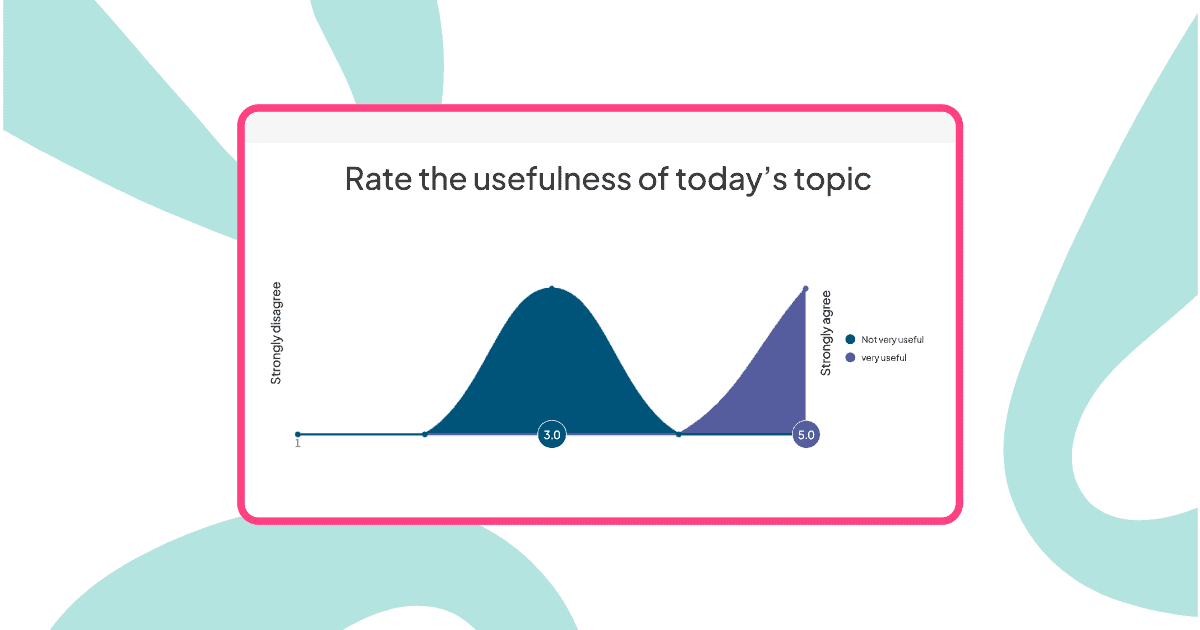Nahunahuna ba nimo kung unsa gyud ang gibati sa imong mga empleyado bahin sa ilang mga tahas, kontribusyon, ug kinatibuk-ang katagbawan sa trabaho?
Ang usa ka makatagbaw nga karera dili na limitado sa usa ka sweldo sa katapusan sa bulan. Sa panahon sa layo nga trabaho, flexible nga oras, ug nag-uswag nga mga tahas sa trabaho, ang kahulugan sa katagbawan sa trabaho nausab pag-ayo.
Ania ang problema: ang tradisyonal nga tinuig nga mga surbey kanunay nga nagbunga ug mubu nga mga rate sa pagtubag, nalangan nga mga panan-aw, ug mga sanitized nga tubag. Gikompleto sila sa mga empleyado nga nag-inusara sa ilang mga lamesa, wala’y koneksyon gikan sa higayon ug nahadlok nga mailhan. Sa panahon nga imong analisahon ang mga resulta, ang mga isyu midako o nakalimtan.
Adunay mas maayo nga paagi. Ang interactive nga mga survey sa katagbawan sa trabaho nga gihimo atol sa mga miting sa team, mga town hall, o mga sesyon sa pagbansay nakakuha og tinuod nga feedback sa higayon—kon ang engagement maoy pinakataas ug matubag nimo ang mga kabalaka sa tinuod nga panahon.
Niini nga giya, among ihatag 46 sample nga mga pangutana para sa imong job satisfaction questionnaire, ipakita kanimo kung unsaon pagbag-o ang mga static nga survey ngadto sa makapadani nga mga panag-istoryahanay, ug makatabang kanimo sa pagpalambo sa usa ka kultura sa trabahoan nga nag-amuma sa pakiglambigit sa mga empleyado, nagpasiugda og kabag-ohan, ug nagtakda sa entablado alang sa malungtarong kalampusan.
Kaundan
- Unsa ang usa ka Pangutana sa Katagbawan sa Trabaho?
- Nganong Maghimo ug Job Satisfaction Questionnaire?
- Ang Kalainan Tali sa Tradisyonal ug Interactive nga mga Survey
- 46 Sample nga mga Pangutana alang sa usa ka Pangutana sa Katagbawan sa Trabaho
- Giunsa Pagpahigayon ang usa ka Epektibo nga Pagsurbi sa Katagbawan sa Trabaho sa AhaSlides
- Ngano nga ang Interactive Surveys Mas Maayo Kay sa Tradisyonal nga mga Porma
- Panguna nga mga Takeaway
Unsa ang usa ka Pangutana sa Katagbawan sa Trabaho?
Ang usa ka pangutana sa katagbawan sa trabaho, nga nailhan usab nga usa ka survey sa katagbawan sa empleyado, usa ka estratehikong himan nga gigamit sa mga propesyonal sa HR ug mga lider sa organisasyon aron masabtan kung unsa ka katumanan ang ilang mga empleyado sa ilang mga tahas.
Naglangkob kini sa mabinantayon nga gihimo nga mga pangutana nga gilaraw aron masakop ang mga kritikal nga lugar lakip ang palibot sa trabaho, mga responsibilidad sa trabaho, relasyon sa mga kauban ug superbisor, bayad, mga oportunidad sa pagtubo, kaayohan, ug uban pa.
Tradisyonal nga pamaagi: Pagpadala ug link sa survey, paghulat sa mga tubag nga mutulo, analisa ang datos sa mga semana sa ulahi, dayon ipatuman ang mga pagbag-o nga gibati nga wala’y koneksyon gikan sa orihinal nga mga kabalaka.
Interactive nga pamaagi: Ipresentar ang mga pangutana nga buhi sa panahon sa mga miting, pagkolekta dayon nga feedback pinaagi sa wala mailhi nga mga botohan ug pulong nga panganod, hisguti ang mga resulta sa tinuud nga oras, ug magtinabangay nga maghimo mga solusyon samtang ang panag-istoryahanay bag-o pa.
Nganong Maghimo ug Job Satisfaction Questionnaire?
Ang panukiduki ni Pew nagpasiugda nga hapit 39% sa mga dili self-employed nga mga trabahante nag-isip sa ilang mga trabaho nga hinungdanon sa ilang kinatibuk-ang pagkatawo. Kini nga sentimento gihulma sa mga hinungdan sama sa kita sa pamilya ug edukasyon, nga adunay 47% sa mga mas taas nga kinitaan ug 53% sa mga postgraduate nga naghatag importansya sa ilang pagkatawo sa trabaho. Kini nga interplay hinungdanon alang sa katagbawan sa empleyado, nga naghimo sa usa ka maayo nga pagkahan-ay nga pangutana sa katagbawan sa trabaho nga hinungdanon alang sa pag-amuma sa katuyoan ug kaayohan.
Ang pagpahigayon sa usa ka pangutana sa katagbawan sa trabaho nagtanyag daghang mga bentaha alang sa mga empleyado ug sa organisasyon:
Maalamon nga Pagsabot
Ang piho nga mga pangutana nagpadayag sa tinuod nga mga pagbati sa mga empleyado, nagpadayag sa mga opinyon, mga kabalaka, ug mga bahin sa katagbawan. Kung gipahigayon nga interactive nga adunay dili mailhan nga mga kapilian sa pagtubag, imong laktawan ang kahadlok sa pag-ila nga kanunay nga mosangpot sa dili matinuoron nga feedback sa tradisyonal nga mga survey.
Pag-ila sa Isyu
Ang gipunting nga mga pangutana nagpunting sa mga punto sa kasakit nga nakaapekto sa moral ug pakiglambigit—may kalabotan sa komunikasyon, kabug-at sa trabaho, o mga oportunidad sa pagtubo. Ang tinuud nga oras nga pulong nga panganod mahimo dayon nga mahanduraw kung diin ang kadaghanan sa mga empleyado naglisud.
Gipahiangay nga mga Solusyon
Ang mga insight nga nakolekta nagtugot sa customized nga mga solusyon, nga nagpakita sa imong pasalig sa pagpauswag sa mga kondisyon sa trabaho. Kung makita sa mga empleyado ang ilang feedback nga gipakita dayon ug gihisgutan sa dayag, gibati nila nga tinuod nga nadungog kaysa gisurbi lang.
Gipauswag nga Pag-apil ug Pagpadayon
Ang pagsulbad sa mga kabalaka base sa mga resulta sa questionnaire makapataas sa engagement, makatampo sa ubos nga turnover ug makapataas sa loyalty. Ang interactive nga mga surbey naghimo sa pagkolekta sa feedback gikan sa usa ka burukratikong ehersisyo ngadto sa usa ka makahuluganon nga panag-istoryahanay.
Ang Kalainan Tali sa Tradisyonal ug Interactive nga mga Survey
| bahin | Tradisyonal nga survey | Interactive nga survey (AhaSlides) |
|---|---|---|
| tayming | Gipadala pinaagi sa email, nahuman nga nag-inusara | Gidumala nga live panahon sa mga miting |
| Ang tubag mikaon | 30-40% nga kasagaran | 85-95% kung gipresentar nga live |
| Dili magpaila | Maduhaduhaon—nabalaka ang mga empleyado bahin sa pagsubay | Tinuod nga anonymity nga walay login nga gikinahanglan |
| engagement | Morag homework | Morag makig-estorya |
| Resulta | Paglabay sa mga adlaw o semana | Instant, real-time nga paghanduraw |
| Action | Nalangan, naputol | Diha-diha nga panaghisgot ug mga solusyon |
| format | Static nga mga porma | Dinamikong poll, word clouds, Q&A, ratings |
Ang yawe nga pagsabot: Mas moapil ang mga tawo kung ang feedback sama sa diyalogo kaysa dokumentasyon.
46 Sample nga mga Pangutana alang sa usa ka Pangutana sa Katagbawan sa Trabaho
Ania ang mga sampol nga pangutana nga giorganisar sumala sa kategorya. Ang matag seksyon naglakip sa giya kung giunsa kini ipresentar nga interactive alang sa labing taas nga pagkamatinud-anon ug pakiglambigit.
Buhat nga Kalikupan
Mga pangutana:
- Unsaon nimo pag-rate ang pisikal nga kaharuhay ug kaluwasan sa imong workspace?
- Kontento ka ba sa kalimpyo ug organisasyon sa trabahoan?
- Gibati ba nimo nga ang atmospera sa opisina nagpasiugda sa usa ka positibo nga kultura sa trabaho?
- Gihatagan ka ba sa gikinahanglan nga mga himan ug mga kapanguhaan aron mahimo ang imong trabaho nga epektibo?
Interactive nga pamaagi sa AhaSlides:
- Gamita ang mga timbangan sa rating (1-5 ka bituon) nga gipakita nga live
- Pag-follow up sa usa ka bukas nga pulong nga panganod: "Sa usa ka pulong, ihulagway ang atmospera sa among trabahoan"
- I-enable ang anonymous mode aron ang mga empleyado matinud-anon nga mag-rate sa pisikal nga kondisyon nga walay kahadlok
- Ipakita dayon ang mga aggregate nga resulta aron masugdan ang panaghisgot
Ngano nga kini molihok: Kung makita sa mga empleyado ang uban nga adunay parehas nga mga kabalaka (pananglitan, daghang mga tawo ang nag-rate sa "mga himan ug kahinguhaan" ingon 2/5), gibati nila nga balido ug mas andam nga magdetalye sa mga follow-up nga sesyon sa Q&A.
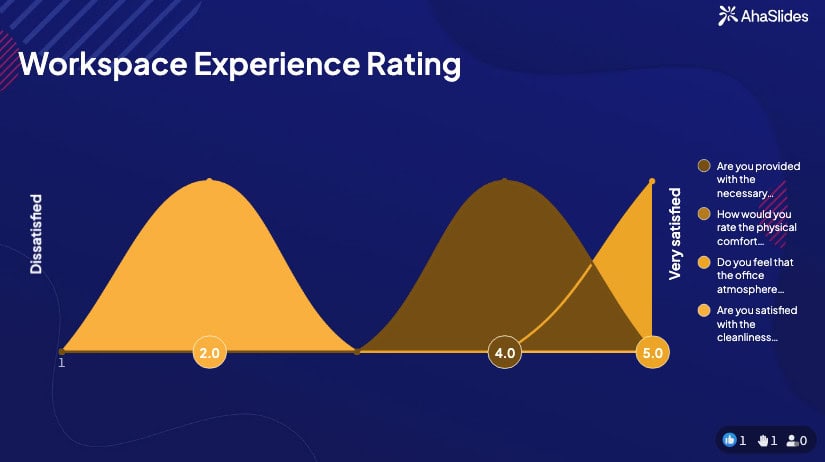
Sulayi ang usa ka template sa poll sa palibot sa trabahoan →
Responsibilidad Job
Mga pangutana:
- Ang imong mga responsibilidad sa trabaho karon nahiuyon ba sa imong mga kahanas ug kwalipikasyon?
- Ang imong mga buluhaton tin-aw nga gihubit ug gipahibalo kanimo?
- Aduna ka bay mga oportunidad sa pag-atubang sa bag-ong mga hagit ug pagpalapad sa imong kahanas?
- Natagbaw ka ba sa lainlain ug kakomplikado sa imong adlaw-adlaw nga buluhaton?
- Gibati ba nimo nga ang imong trabaho naghatag usa ka pagbati sa katuyoan ug katumanan?
- Natagbaw ka ba sa lebel sa awtoridad sa paghimog desisyon nga naa nimo sa imong tahas?
- Nagtuo ka ba nga ang imong mga responsibilidad sa trabaho nahiuyon sa kinatibuk-ang katuyoan ug misyon sa organisasyon?
- Gihatagan ka ba og tin-aw nga mga giya ug mga gilauman alang sa imong mga buluhaton ug proyekto sa trabaho?
- Unsa ka maayo ang imong gibati nga ang imong mga responsibilidad sa trabaho nakatampo sa kalampusan ug pagtubo sa kompanya?
Interactive nga pamaagi sa AhaSlides:
- Ipresentar ang oo/dili poll alang sa katin-awan nga mga pangutana (pananglitan, "Ang imong mga buluhaton tin-aw nga gihubit?")
- Gamita ang mga sukdanan sa rating para sa lebel sa katagbawan
- Sunda ang bukas nga Q&A: "Unsa nga mga responsibilidad ang gusto nimong idugang o tangtangon?"
- Paghimo og pulong nga panganod: "Ihulagway ang imong papel sa tulo ka pulong"
Pro tip: Ang anonymous nga Q&A nga bahin labi ka kusgan dinhi. Ang mga empleyado mahimong mosumitir sa mga pangutana sama sa "Nganong wala kita'y dugang nga awtonomiya sa paghimog desisyon?" nga walay kahadlok nga mailhan, nagtugot sa mga manedyer sa pagsulbad sa mga sistematikong isyu sa dayag.
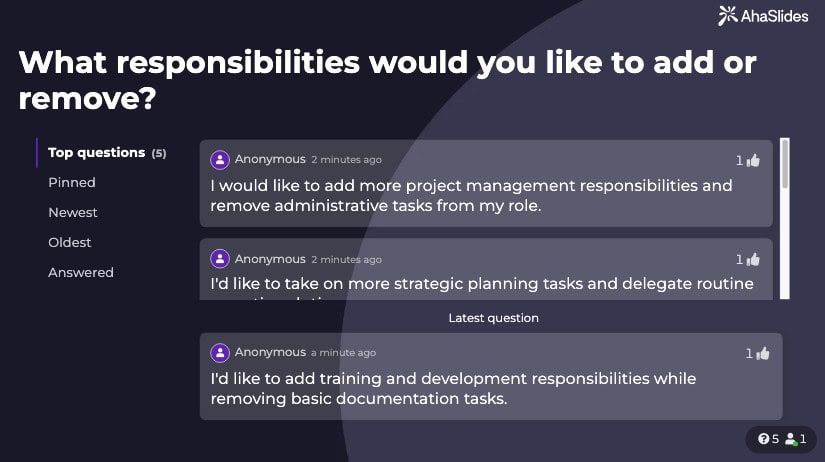
Pagdumala ug Pagpangulo
Mga pangutana:
- Unsaon nimo pag-rate ang kalidad sa komunikasyon tali kanimo ug sa imong superbisor?
- Nakadawat ka ba og makatabang nga feedback ug giya sa imong pasundayag?
- Gidasig ka ba nga ipahayag ang imong mga opinyon ug sugyot sa imong superbisor?
- Gibati ba nimo nga gipabilhan sa imong superbisor ang imong mga kontribusyon ug giila ang imong mga paningkamot?
- Natagbaw ka ba sa istilo sa pagpangulo ug pamaagi sa pagdumala sa sulod sa imong departamento?
- Unsa nga mga matang sa kahanas sa pagpangulo ang imong gihunahuna nga labing epektibo sa imong team?
Interactive nga pamaagi sa AhaSlides:
- Gamit ug anonymous rating scales para sa sensitibo nga superbisor feedback
- Ipresentar ang mga kapilian sa estilo sa pagpangulo (demokratiko, pagtudlo, pagbag-o, ug uban pa) ug pangutana kung kinsa ang gusto sa mga empleyado
- I-enable ang live Q&A diin ang mga empleyado makapangutana bahin sa pamaagi sa pagdumala
- Paghimo mga ranggo: "Unsa ang labing hinungdanon kanimo sa usa ka superbisor?" (Komunikasyon, Pag-ila, Feedback, Autonomy, Suporta)
Nganong importante ang anonymity: Sumala sa imong positioning worksheet, ang mga propesyonal sa HR kinahanglan nga "maghimo og luwas nga mga luna alang sa matinud-anon nga panaghisgot". Ang interactive nga anonymous nga mga botohan atol sa mga town hall nagtugot sa mga empleyado sa pag-rate sa liderato nga matinud-anon nga walay mga kabalaka sa karera—usa ka butang nga gipakigbisogan sa tradisyonal nga mga survey nga makab-ot nga makapakombinsir.
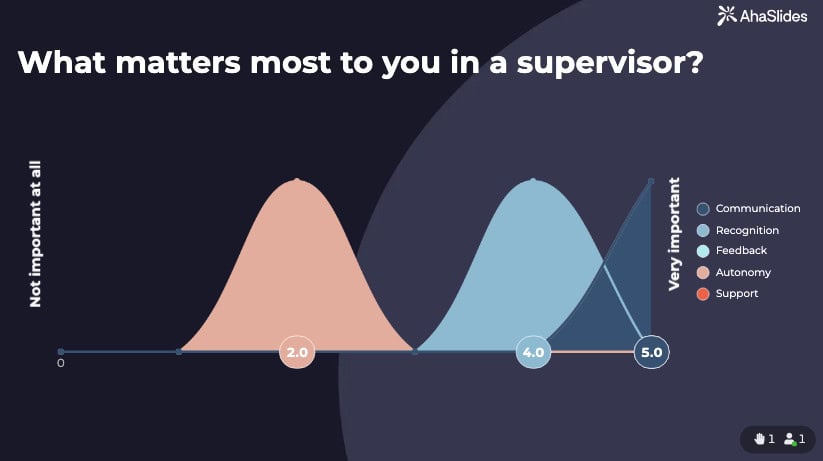
Pag-uswag ug Pag-uswag sa Karera
Mga pangutana:
- Gihatagan ka ba og mga oportunidad alang sa propesyonal nga pagtubo ug pag-uswag?
- Unsa ka katagbawan sa mga programa sa pagbansay ug pagpalambo nga gitanyag sa organisasyon?
- Nagtuo ka ba nga ang imong papel karon nahiuyon sa imong dugay nga mga katuyoan sa karera?
- Gihatagan ka ba og kahigayonan sa pagkuha sa mga tahas sa pagpangulo o espesyal nga mga proyekto?
- Nakadawat ka ba og suporta alang sa pagpadayon sa dugang nga edukasyon o pagpauswag sa kahanas?
Interactive nga pamaagi sa AhaSlides:
- Poll: "Unsa nga matang sa propesyonal nga kalamboan ang makabenepisyo kanimo pag-ayo?" (Paghanas sa pagpangulo, kahanas sa teknikal, Sertipikasyon, Mentorship, Lateral nga paglihok)
- Pulong sa panganod: "Asa nimo makita ang imong kaugalingon sa 3 ka tuig?"
- Rating scale: "Unsa ka suportado ang imong gibati sa imong pag-uswag sa karera?" (1-10)
- Ablihi ang Q&A alang sa mga empleyado nga mangutana bahin sa piho nga mga oportunidad sa pag-uswag
Estratehikong bentaha: Dili sama sa tradisyonal nga mga survey diin kini nga datos anaa sa usa ka spreadsheet, ang pagpresentar sa mga pangutana sa pagpalambo sa karera nga buhi atol sa quarterly nga mga review nagtugot sa HR sa paghisgot dayon sa mga badyet sa pagbansay, mga programa sa pagtudlo, ug mga oportunidad sa internal nga paglihok samtang aktibo ang panag-istoryahanay.
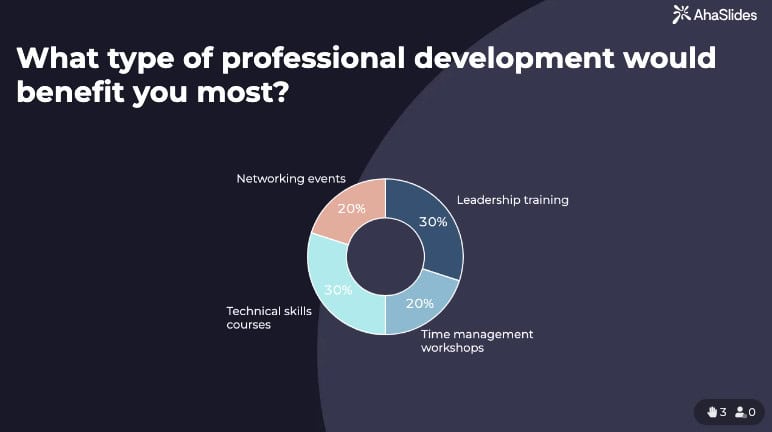
Pagbayad ug mga Benepisyo
Mga pangutana:
- Kontento ka ba sa imong kasamtangang suweldo ug bayad nga pakete, lakip na ang mga benepisyo?
- Gibati ba nimo nga ang imong mga kontribusyon ug mga nahimo tukma nga gigantihan?
- Ang mga benepisyo ba nga gitanyag sa organisasyon komprehensibo ug angay alang sa imong mga panginahanglan?
- Unsaon nimo pag-rate ang transparency ug kaangayan sa performance evaluation ug compensation process?
- Natagbaw ka ba sa mga oportunidad alang sa mga bonus, insentibo, o mga ganti?
- Kontento ka ba sa annual leave policy?
Interactive nga pamaagi sa AhaSlides:
- Anonymous oo/dili poll para sa sensitibo nga mga pangutana sa sweldo
- Daghang pagpili: "Unsa nga mga benepisyo ang labing hinungdanon kanimo?" (Pag-atiman sa Panglawas, Pagka-flexible, Badyet sa pagkat-on, mga programa sa Kaayohan, Pagretiro)
- Rating scale: "Unsa ka patas ang among bayad kalabot sa imong kontribusyon?"
- Word cloud: "Unsa ang usa ka kaayohan nga makapauswag sa imong katagbawan nga labing?"
Kritikal nga nota: Dinhi diin ang wala mailhi nga interactive nga mga survey tinuod nga nagdan-ag. Ang mga empleyado panagsa ra mohatag og matinud-anon nga feedback sa kompensasyon sa tradisyonal nga mga survey nga nagkinahanglan og mga kredensyal sa pag-login. Pagpuyo sa anonymous nga botohan atol sa mga town hall, diin ang mga tubag makita nga walay mga ngalan, nagmugna og sikolohikal nga kaluwasan alang sa tinuod nga feedback.
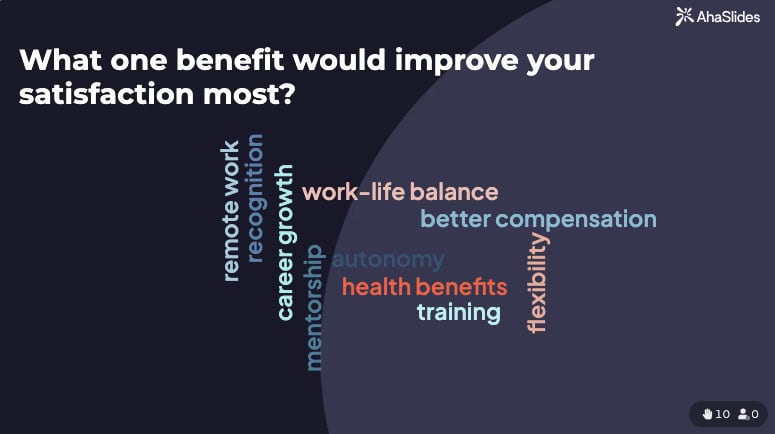
Paghimo sa imong sesyon sa feedback sa bayad →
Mga Relasyon ug Kolaborasyon
Mga pangutana:
- Unsa ka maayo ang imong pagtinabangay ug pagpakigsulti sa imong mga kauban?
- Gibati ba nimo ang usa ka pagbati sa panaghigalaay ug pagtinabangay sulod sa imong departamento?
- Natagbaw ka ba sa lebel sa pagtahod ug kooperasyon sa imong mga kauban?
- Aduna ka bay mga oportunidad nga makig-uban sa mga kauban gikan sa lainlaing mga departamento o mga grupo?
- Komportable ka ba nga mangayo og tabang o tambag gikan sa imong mga kauban kung gikinahanglan?
Interactive nga pamaagi sa AhaSlides:
- Mga timbangan sa rating alang sa kalidad sa kolaborasyon
- Word cloud: "Ihulagway ang kultura sa among team sa usa ka pulong"
- Daghang pagpili: "Kapila ka magtinabangay sa mga departamento?" (Adlaw-adlaw, Semana, Buwan, Talagsa, Dili Gayud)
- Anonymous nga Q&A para sa interpersonal nga mga isyu
Kaayohan ug Balanse sa Trabaho-Kinabuhi
Mga pangutana:
- Unsa ka kontento sa balanse sa trabaho-kinabuhi nga gihatag sa organisasyon?
- Gibati ba nimo nga igo nga gisuportahan sa kompanya sa pagdumala sa stress ug pagpadayon sa imong kahimsog sa pangisip?
- Komportable ka ba sa pagpangita og tabang o mga kapanguhaan alang sa pagdumala sa personal o may kalabutan sa trabaho nga mga hagit?
- Unsa ka sagad ka moapil sa mga programa sa kahimsog o kalihokan nga gihatag sa organisasyon?
- Nagtuo ka ba nga ang kompanya nagpabili ug nag-una sa kaayohan sa mga empleyado niini?
- Natagbaw ka ba sa pisikal nga palibot sa trabaho bahin sa kahupayan, suga, ug ergonomya?
- Unsa ka maayo ang pag-accommodate sa organisasyon sa imong mga panginahanglanon sa panglawas ug kaayohan (pananglitan, flexible nga oras, mga opsyon sa layo nga trabaho)?
- Gidasig ka ba sa pagpahulay ug pagdiskonekta sa trabaho kung gikinahanglan aron mag-recharge?
- Unsa ka sagad nga gibati nimo nga nabug-atan o na-stress tungod sa mga hinungdan nga may kalabotan sa trabaho?
- Natagbaw ka ba sa mga benepisyo sa kahimsog ug kahimsog nga gitanyag sa organisasyon?
Interactive nga pamaagi sa AhaSlides:
- Frequency scales: "Unsa ka sagad nimo gibati ang stress?" (Dili, Panagsa, Usahay, Kanunay, Kanunay)
- Oo/dili poll sa suporta sa kaayohan
- Anonymous nga slider: "I-rate ang imong karon nga lebel sa pagkasunog" (1-10)
- Word cloud: "Unsa ang labing makapauswag sa imong kaayohan?"
- Ablihi ang Q&A para sa mga empleyado nga ipaambit ang mga kabalaka sa kaayohan sa dili mailhan
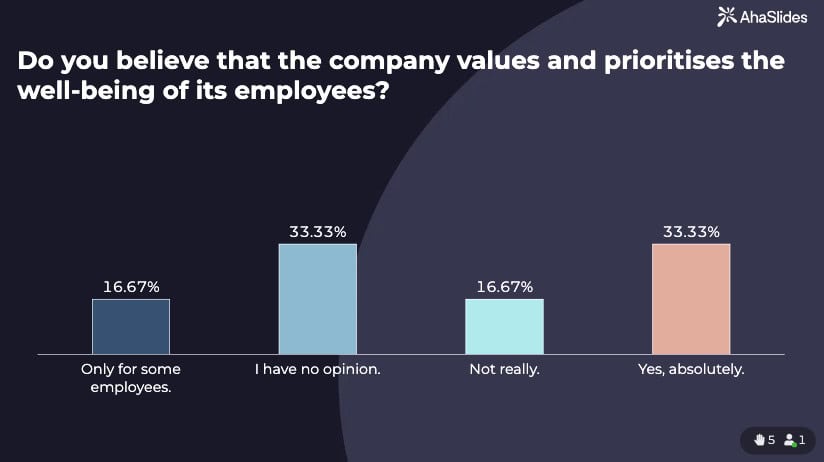
Nganong hinungdanon kini: Ang imong positioning worksheet nagpaila nga ang mga HR professionals nakigbisog sa "employee engagement and feedback" ug "pagmugna ug luwas nga mga luna alang sa matinud-anon nga diskusyon". Ang mga pangutana bahin sa kaayohan kay sensitibo kaayo—nahadlok ang mga empleyado nga makita nga huyang o walay pasalig kon moangkon sila nga burnout. Ang mga interactive nga anonymous nga survey nagtangtang niini nga babag.
Sa kinatibuk-ang Katagbawan
Katapusan nga pangutana: 46. Sa sukod nga 1-10, unsa ka dako ang posibilidad nga imong irekomendar kini nga kompanya isip usa ka maayong dapit sa pagtrabaho? (Employee Net Promoter Score)
Interactive nga pamaagi:
- Pag-follow up base sa mga resulta: Kung ang mga marka gamay, pangutana dayon "Unsa ang usa ka butang nga mahimo namon usbon aron mapauswag ang imong marka?"
- Ipakita ang eNPS sa tinuud nga oras aron ang pagpangulo makakita dayon nga sentimento
- Gamita ang mga resulta sa pagduso sa transparent nga panag-istoryahanay bahin sa organisasyonal nga mga kalamboan
Giunsa Pagpahigayon ang usa ka Epektibo nga Pagsurbi sa Katagbawan sa Trabaho sa AhaSlides
Lakang 1: Pilia ang Imong Format
Opsyon A: Pagpuyo atol sa all-hand meetings
- Pagpresentar og 8-12 ka importanteng pangutana atol sa quarterly town halls
- Gamit ug anonymous mode para sa sensitibong mga topiko
- Hisguti dayon ang mga resulta uban sa grupo
- Labing maayo alang sa: Pagtukod og pagsalig, diha-diha nga aksyon, pagtinabangay sa pagsulbad sa problema
Opsyon B: Kaugalingon nga paspas apan interactive
- Ipaambit ang link sa presentasyon nga ma-access sa mga empleyado bisan kanus-a
- Ilakip ang tanang 46 ka pangutana nga giorganisar sumala sa kategorya
- Pagtakda og deadline sa pagkompleto
- Labing maayo alang sa: Comprehensive data collection, flexible timing
Opsyon C: Hybrid nga pamaagi (girekomenda)
- Ipadala ang 5-7 ka kritikal nga mga pangutana isip self-paced polls
- Ipresentar ang mga resulta ug top 3 nga mga kabalaka live sa sunod nga miting sa team
- Gamita ang live Q&A aron mas lawom ang mga isyu
- Labing maayo alang sa: Labing kadaghan nga partisipasyon nga adunay makahuluganon nga diskusyon
Lakang 2: I-set up ang Imong Survey sa AhaSlides
Mga Feature nga gamiton:
- Mga timbangan sa rating para sa lebel sa katagbawan
- Multiple choice polls para sa preference nga mga pangutana
- Mga panganod sa pulong sa paghanduraw sa komon nga mga tema
- Ablihi ang Q&A alang sa mga empleyado nga mangutana sa dili mailhan nga mga pangutana
- Anonymous nga mode aron masiguro ang sikolohikal nga kaluwasan
- Gipakita ang live nga mga resulta aron ipakita ang transparency
Tip sa pagdaginot sa panahon: Gamita ang AhaSlides' AI generator aron dali nga mahimo ang imong survey gikan sa kini nga lista sa pangutana, unya i-customize para sa piho nga mga panginahanglanon sa imong organisasyon.
Lakang 3: Ipahibalo ang Katuyoan
Sa dili pa ilunsad ang imong survey, ipasabut:
- Ngano nga imong gihimo kini (dili lang "tungod kay panahon na alang sa tinuig nga mga survey")
- Sa unsang paagi gamiton ang mga tubag
- Kana nga wala mailhi nga mga tubag tinuod nga wala mailhi
- Kanus-a ug unsaon nimo pagpaambit ang mga resulta ug molihok
script sa pagtukod sa pagsalig: "Gusto namon nga masabtan kung unsa ang imong tinuud nga gibati bahin sa pagtrabaho dinhi. Gigamit namon ang dili nagpakilala nga interactive nga mga botohan tungod kay nahibal-an namon nga ang tradisyonal nga mga survey dili makuha ang imong matinud-anon nga feedback. Ang imong mga tubag makita nga wala’y mga ngalan, ug among hisgutan ang mga resulta aron magtinabangay nga makahimo og mga solusyon."
Lakang 4: Ipresentar nga Live (Kung Magamit)
Istruktura sa miting:
- Pasiuna (2 min): Ipasabut ang katuyoan ug dili mailhan
- Mga pangutana sa survey (15-20 min): Ipresentar ang mga botohan sa tinagsa, nga nagpakita sa mga live nga resulta
- Panaghisgot (15-20 min): Tubaga dayon ang nag-unang mga kabalaka
- Pagplano sa aksyon (10 min): Pagpasalig sa piho nga sunod nga mga lakang
- Pagsunod nga Q&A (10 min): Ablihi ang salog para sa anonymous nga mga pangutana
Pro tip: Kung makita ang sensitibo nga mga resulta (pananglitan, 70% ang rate sa komunikasyon sa pagpangulo ingon kabus), ilha dayon sila: "Kini usa ka hinungdanon nga feedback. Atong hisgutan kung unsa ang kahulugan sa 'dili maayo nga komunikasyon' kanimo. Gamita ang Q&A aron ipaambit ang piho nga mga pananglitan nga dili mailhan."
Lakang 5: Lihok sa mga Resulta
Dinhi diin ang mga interactive nga survey nagmugna og competitive nga bentaha. Tungod kay nakatigom ka og feedback atol sa live nga panag-istoryahanay:
- Ang mga empleyado nakakita na og mga resulta
- Nagpasalig ka sa mga aksyon sa publiko
- Ang follow-through gilauman ug makita
- Ang pagsalig matukod kon ang mga saad tumanon
Template sa plano sa aksyon:
- Ipaambit ang detalyadong mga resulta sulod sa 48 ka oras
- Pag-ila sa top 3 nga mga lugar alang sa pag-uswag
- Pagporma og mga working group aron makahimo og mga solusyon
- Ipahibalo ang pag-uswag kada bulan
- Pag-survey pag-usab sulod sa 6 ka bulan aron masukod ang kalamboan
Ngano nga ang Interactive Surveys Mas Maayo Kay sa Tradisyonal nga mga Porma
Sumala sa imong panginahanglan sa organisasyon, kinahanglan nimo:
- "Sukaron ang pakiglambigit sa empleyado sa panahon sa mga inisyatibo sa HR"
- "Pasayon ang anonymous nga Q&A session sa mga town hall"
- "Koletaha ang sentimento sa empleyado gamit ang pulong nga panganod ug live poll"
- "Paghimo luwas nga mga luna alang sa matinud-anon nga panaghisgot"
Ang tradisyonal nga mga himan sa survey sama sa Google Forms o SurveyMonkey dili makahatag niini nga kasinatian. Nagkolekta sila og datos, apan wala sila maghimo og dayalogo. Nagtigum sila og mga tubag, apan wala sila nagtukod og pagsalig.
Ang mga interactive nga plataporma sama sa AhaSlides nagbag-o sa koleksyon sa feedback gikan sa usa ka burukratikong ehersisyo ngadto sa usa ka makahuluganon nga panag-istoryahanay diin:
- Nakita sa mga empleyado nga hinungdanon ang ilang mga tingog sa tinuud nga oras
- Gipakita sa mga lider ang diha-diha nga pasalig sa pagpaminaw
- Ang pagka-anonymity nagwagtang sa kahadlok samtang ang transparency nagtukod og pagsalig
- Ang panaghisgut motultol sa mga solusyon sa kolaborasyon
- Ang datos nahimong starter sa panag-istoryahanay, dili usa ka report nga anaa sa drawer
Panguna nga mga Takeaway
✅ Ang mga survey sa katagbawan sa trabaho usa ka estratehikong himan, dili mga administratibong checkbox. Gipadayag nila kung unsa ang nag-aghat sa pag-apil, pagpadayon, ug pasundayag.
✅ Ang mga interactive nga survey makahatag ug mas maayong resulta kay sa tradisyonal nga mga porma—mas taas nga tubag, mas matinud-anon nga feedback, ug diha-diha nga mga kahigayonan sa panaghisgot.
✅ Anonymity plus transparency nagmugna sa sikolohikal nga kaluwasan nga gikinahanglan alang sa tinuod nga feedback. Ang mga empleyado matinud-anon nga motubag kung nahibal-an nila nga ang mga tubag dili mailhan apan nakita nga ang mga lider naglihok.
✅ Ang 46 ka pangutana niini nga giya naglangkob sa mga kritikal nga dimensyon sa katagbawan sa trabaho: palibot, mga responsibilidad, pagpangulo, pagtubo, bayad, relasyon, ug kaayohan.
✅ Ang tinuod nga panahon nga mga resulta makahimo sa diha-diha nga aksyon. Kung makita sa mga empleyado ang ilang feedback nga makita dayon ug gihisgutan sa dayag, gibati nila nga nadungog kaysa gisurbi lang.
✅ Importante ang mga himan. Ang mga plataporma sama sa AhaSlides nga adunay live poll, word clouds, anonymous nga Q&A, ug real-time nga mga resulta nga nagpakita sa paghimo sa static nga mga pangutana ngadto sa dinamikong mga panag-istoryahanay nga nagduso sa pagbag-o sa organisasyon.
mga pakisayran:




